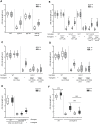Structural and Functional Recovery of Sensory Cilia in C. elegans IFT Mutants upon Aging
- PMID: 27906968
- PMCID: PMC5131903
- DOI: 10.1371/journal.pgen.1006325
Structural and Functional Recovery of Sensory Cilia in C. elegans IFT Mutants upon Aging
Abstract
The majority of cilia are formed and maintained by the highly conserved process of intraflagellar transport (IFT). Mutations in IFT genes lead to ciliary structural defects and systemic disorders termed ciliopathies. Here we show that the severely truncated sensory cilia of hypomorphic IFT mutants in C. elegans transiently elongate during a discrete period of adult aging leading to markedly improved sensory behaviors. Age-dependent restoration of cilia morphology occurs in structurally diverse cilia types and requires IFT. We demonstrate that while DAF-16/FOXO is dispensable, the age-dependent suppression of cilia phenotypes in IFT mutants requires cell-autonomous functions of the HSF1 heat shock factor and the Hsp90 chaperone. Our results describe an unexpected role of early aging and protein quality control mechanisms in suppressing ciliary phenotypes of IFT mutants, and suggest possible strategies for targeting subsets of ciliopathies.
Conflict of interest statement
The authors have declared that no competing interests exist.
Figures





Comment in
-
Middle Age Has Its Advantages.PLoS Genet. 2016 Dec 1;12(12):e1006426. doi: 10.1371/journal.pgen.1006426. eCollection 2016 Dec. PLoS Genet. 2016. PMID: 27906958 Free PMC article. No abstract available.
References
-
- Murcia NS, Richards WG, Yoder BK, Mucenski ML, Dunlap JR, Woychik RP. The Oak Ridge Polycystic Kidney (orpk) disease gene is required for left-right axis determination. Development. 2000;127: 2347–2355. - PubMed
MeSH terms
Substances
Grants and funding
LinkOut - more resources
Full Text Sources
Other Literature Sources
Research Materials
Miscellaneous

